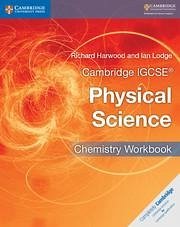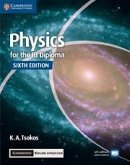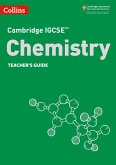17,99 €
inkl. MwSt.
Versandfertig in über 4 Wochen

9 °P sammeln
- Broschiertes Buch
- Merkliste
- Auf die Merkliste
- Bewerten Bewerten
- Teilen
- Produkt teilen
- Produkterinnerung
- Produkterinnerung
Cambridge IGCSE(R) Physical Science resources tailored to the 0652 syllabus for first examination in 2019, and all components of the series are endorsed by Cambridge International Examinations.
Andere Kunden interessierten sich auch für
![Cambridge Igcse(tm) Chemistry Workbook with Digital Access (2 Years) Cambridge Igcse(tm) Chemistry Workbook with Digital Access (2 Years)]() Richard HarwoodCambridge Igcse(tm) Chemistry Workbook with Digital Access (2 Years)22,99 €
Richard HarwoodCambridge Igcse(tm) Chemistry Workbook with Digital Access (2 Years)22,99 €![Cambridge Igcse(tm) Chemistry Practical Workbook with Digital Access (2 Years) Cambridge Igcse(tm) Chemistry Practical Workbook with Digital Access (2 Years)]() Michael StrachanCambridge Igcse(tm) Chemistry Practical Workbook with Digital Access (2 Years)22,99 €
Michael StrachanCambridge Igcse(tm) Chemistry Practical Workbook with Digital Access (2 Years)22,99 €![Cambridge Igcse(tm) Chemistry Coursebook with Digital Access (2 Years) Cambridge Igcse(tm) Chemistry Coursebook with Digital Access (2 Years)]() Richard HarwoodCambridge Igcse(tm) Chemistry Coursebook with Digital Access (2 Years)54,99 €
Richard HarwoodCambridge Igcse(tm) Chemistry Coursebook with Digital Access (2 Years)54,99 €![Physics for the IB Diploma Coursebook with Cambridge Elevate Enhanced Edition (2 Years) Physics for the IB Diploma Coursebook with Cambridge Elevate Enhanced Edition (2 Years)]() K A TsokosPhysics for the IB Diploma Coursebook with Cambridge Elevate Enhanced Edition (2 Years)99,99 €
K A TsokosPhysics for the IB Diploma Coursebook with Cambridge Elevate Enhanced Edition (2 Years)99,99 €![Cambridge Checkpoint Science Challenge Workbook 8 Cambridge Checkpoint Science Challenge Workbook 8]() Mary JonesCambridge Checkpoint Science Challenge Workbook 819,99 €
Mary JonesCambridge Checkpoint Science Challenge Workbook 819,99 €![Cambridge Checkpoint Science Challenge Workbook 7 Cambridge Checkpoint Science Challenge Workbook 7]() Mary JonesCambridge Checkpoint Science Challenge Workbook 719,99 €
Mary JonesCambridge Checkpoint Science Challenge Workbook 719,99 €![Collins Cambridge Igcse(tm) - Cambridge Igcse(tm) Chemistry Teacher's Guide Collins Cambridge Igcse(tm) - Cambridge Igcse(tm) Chemistry Teacher's Guide]() Chris SunleyCollins Cambridge Igcse(tm) - Cambridge Igcse(tm) Chemistry Teacher's Guide129,99 €
Chris SunleyCollins Cambridge Igcse(tm) - Cambridge Igcse(tm) Chemistry Teacher's Guide129,99 €-
-
-
Cambridge IGCSE(R) Physical Science resources tailored to the 0652 syllabus for first examination in 2019, and all components of the series are endorsed by Cambridge International Examinations.
Hinweis: Dieser Artikel kann nur an eine deutsche Lieferadresse ausgeliefert werden.
Hinweis: Dieser Artikel kann nur an eine deutsche Lieferadresse ausgeliefert werden.
Produktdetails
- Produktdetails
- Verlag: Cambridge University Press
- Seitenzahl: 136
- Erscheinungstermin: 27. April 2017
- Englisch
- Abmessung: 279mm x 221mm x 8mm
- Gewicht: 367g
- ISBN-13: 9781316633519
- ISBN-10: 1316633519
- Artikelnr.: 45798871
- Herstellerkennzeichnung
- Libri GmbH
- Europaallee 1
- 36244 Bad Hersfeld
- gpsr@libri.de
- Verlag: Cambridge University Press
- Seitenzahl: 136
- Erscheinungstermin: 27. April 2017
- Englisch
- Abmessung: 279mm x 221mm x 8mm
- Gewicht: 367g
- ISBN-13: 9781316633519
- ISBN-10: 1316633519
- Artikelnr.: 45798871
- Herstellerkennzeichnung
- Libri GmbH
- Europaallee 1
- 36244 Bad Hersfeld
- gpsr@libri.de
Introduction
How to use this book
C1. The particulate nature of matter
C1.1 Changing physical state
C1.2 Plotting a cooling curve
C2. Experimental techniques
C2.1 Diffusion, solubility and separation
C2.2 Chromatography at the races
C3. Atoms, elements and compounds
C3.1 Atomic structure
C3.2 The first four periods
C3.3 The chemical bonding in simple molecules
C3.4 The nature of ionic lattices
C4. Stoichiometry
C4.1 Formulae of ionic compounds
C4.2 Making magnesium oxide - a quantitative investigation
C4.3 The analysis of titration results
C4.4 Calculating formula masses
C4.5 A sense of proportion in chemistry
C4.6 Finding the mass of 5 cm of magnesium ribbon
C4.7 Reacting volumes of gases
C5. Electricity and chemistry
C5.1 The nature of electrolysis
C5.2 Making and 'breaking' copper chloride
C6. Energy changes in chemical reactions
C6.1 Energy diagrams
C6.2 The collision theory of reaction rates
C6.3 The influence of surface area on the rate of reaction
C6.4 Finding the rate of a reaction producing a gas
C7. Acids, bases and salts
C7.1 Acid and base reactions - neutralisation
C7.2 Types of salt
C7.3 Descaling a coffee machine
C7.4 Thermochemistry - investigating the neutralisation of an acid by an alkali
C8. The Periodic Table
C8.1 Trends in the halogens
C8.2 Displacement reactions of the halogens
C8.3 Group I: The alkali metals
C9. Metals
C9.1 The reactivity series of metals
C9.2 Energy from displacement reactions
C9.3 Metals and alloys
C10. Air and water
C10.1 Atmospheric pollution, industry and transport
C10.2 Clean water is crucial
C11. Organic chemistry
C11.1 Families of hydrocarbons
C11.2 Unsaturated hydrocarbons (the alkenes)
C11.3 The alcohols as fuels
C11.4 Essential processes of the petrochemical industry
C11.5 Addition polymerisation
C12. Analysis
C12.1 Titration analysis
C12.2 Chemical analysis
C12.3 Planning a controlled experiment
C12.4 Chemical testing and evaluation
C12.5 Experimental design
Answers.
How to use this book
C1. The particulate nature of matter
C1.1 Changing physical state
C1.2 Plotting a cooling curve
C2. Experimental techniques
C2.1 Diffusion, solubility and separation
C2.2 Chromatography at the races
C3. Atoms, elements and compounds
C3.1 Atomic structure
C3.2 The first four periods
C3.3 The chemical bonding in simple molecules
C3.4 The nature of ionic lattices
C4. Stoichiometry
C4.1 Formulae of ionic compounds
C4.2 Making magnesium oxide - a quantitative investigation
C4.3 The analysis of titration results
C4.4 Calculating formula masses
C4.5 A sense of proportion in chemistry
C4.6 Finding the mass of 5 cm of magnesium ribbon
C4.7 Reacting volumes of gases
C5. Electricity and chemistry
C5.1 The nature of electrolysis
C5.2 Making and 'breaking' copper chloride
C6. Energy changes in chemical reactions
C6.1 Energy diagrams
C6.2 The collision theory of reaction rates
C6.3 The influence of surface area on the rate of reaction
C6.4 Finding the rate of a reaction producing a gas
C7. Acids, bases and salts
C7.1 Acid and base reactions - neutralisation
C7.2 Types of salt
C7.3 Descaling a coffee machine
C7.4 Thermochemistry - investigating the neutralisation of an acid by an alkali
C8. The Periodic Table
C8.1 Trends in the halogens
C8.2 Displacement reactions of the halogens
C8.3 Group I: The alkali metals
C9. Metals
C9.1 The reactivity series of metals
C9.2 Energy from displacement reactions
C9.3 Metals and alloys
C10. Air and water
C10.1 Atmospheric pollution, industry and transport
C10.2 Clean water is crucial
C11. Organic chemistry
C11.1 Families of hydrocarbons
C11.2 Unsaturated hydrocarbons (the alkenes)
C11.3 The alcohols as fuels
C11.4 Essential processes of the petrochemical industry
C11.5 Addition polymerisation
C12. Analysis
C12.1 Titration analysis
C12.2 Chemical analysis
C12.3 Planning a controlled experiment
C12.4 Chemical testing and evaluation
C12.5 Experimental design
Answers.
Introduction
How to use this book
C1. The particulate nature of matter
C1.1 Changing physical state
C1.2 Plotting a cooling curve
C2. Experimental techniques
C2.1 Diffusion, solubility and separation
C2.2 Chromatography at the races
C3. Atoms, elements and compounds
C3.1 Atomic structure
C3.2 The first four periods
C3.3 The chemical bonding in simple molecules
C3.4 The nature of ionic lattices
C4. Stoichiometry
C4.1 Formulae of ionic compounds
C4.2 Making magnesium oxide - a quantitative investigation
C4.3 The analysis of titration results
C4.4 Calculating formula masses
C4.5 A sense of proportion in chemistry
C4.6 Finding the mass of 5 cm of magnesium ribbon
C4.7 Reacting volumes of gases
C5. Electricity and chemistry
C5.1 The nature of electrolysis
C5.2 Making and 'breaking' copper chloride
C6. Energy changes in chemical reactions
C6.1 Energy diagrams
C6.2 The collision theory of reaction rates
C6.3 The influence of surface area on the rate of reaction
C6.4 Finding the rate of a reaction producing a gas
C7. Acids, bases and salts
C7.1 Acid and base reactions - neutralisation
C7.2 Types of salt
C7.3 Descaling a coffee machine
C7.4 Thermochemistry - investigating the neutralisation of an acid by an alkali
C8. The Periodic Table
C8.1 Trends in the halogens
C8.2 Displacement reactions of the halogens
C8.3 Group I: The alkali metals
C9. Metals
C9.1 The reactivity series of metals
C9.2 Energy from displacement reactions
C9.3 Metals and alloys
C10. Air and water
C10.1 Atmospheric pollution, industry and transport
C10.2 Clean water is crucial
C11. Organic chemistry
C11.1 Families of hydrocarbons
C11.2 Unsaturated hydrocarbons (the alkenes)
C11.3 The alcohols as fuels
C11.4 Essential processes of the petrochemical industry
C11.5 Addition polymerisation
C12. Analysis
C12.1 Titration analysis
C12.2 Chemical analysis
C12.3 Planning a controlled experiment
C12.4 Chemical testing and evaluation
C12.5 Experimental design
Answers.
How to use this book
C1. The particulate nature of matter
C1.1 Changing physical state
C1.2 Plotting a cooling curve
C2. Experimental techniques
C2.1 Diffusion, solubility and separation
C2.2 Chromatography at the races
C3. Atoms, elements and compounds
C3.1 Atomic structure
C3.2 The first four periods
C3.3 The chemical bonding in simple molecules
C3.4 The nature of ionic lattices
C4. Stoichiometry
C4.1 Formulae of ionic compounds
C4.2 Making magnesium oxide - a quantitative investigation
C4.3 The analysis of titration results
C4.4 Calculating formula masses
C4.5 A sense of proportion in chemistry
C4.6 Finding the mass of 5 cm of magnesium ribbon
C4.7 Reacting volumes of gases
C5. Electricity and chemistry
C5.1 The nature of electrolysis
C5.2 Making and 'breaking' copper chloride
C6. Energy changes in chemical reactions
C6.1 Energy diagrams
C6.2 The collision theory of reaction rates
C6.3 The influence of surface area on the rate of reaction
C6.4 Finding the rate of a reaction producing a gas
C7. Acids, bases and salts
C7.1 Acid and base reactions - neutralisation
C7.2 Types of salt
C7.3 Descaling a coffee machine
C7.4 Thermochemistry - investigating the neutralisation of an acid by an alkali
C8. The Periodic Table
C8.1 Trends in the halogens
C8.2 Displacement reactions of the halogens
C8.3 Group I: The alkali metals
C9. Metals
C9.1 The reactivity series of metals
C9.2 Energy from displacement reactions
C9.3 Metals and alloys
C10. Air and water
C10.1 Atmospheric pollution, industry and transport
C10.2 Clean water is crucial
C11. Organic chemistry
C11.1 Families of hydrocarbons
C11.2 Unsaturated hydrocarbons (the alkenes)
C11.3 The alcohols as fuels
C11.4 Essential processes of the petrochemical industry
C11.5 Addition polymerisation
C12. Analysis
C12.1 Titration analysis
C12.2 Chemical analysis
C12.3 Planning a controlled experiment
C12.4 Chemical testing and evaluation
C12.5 Experimental design
Answers.







